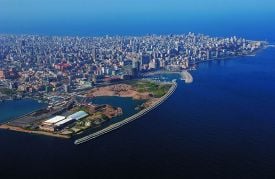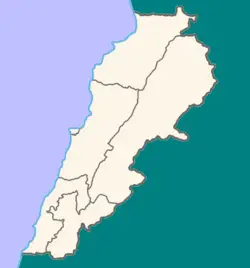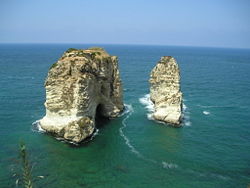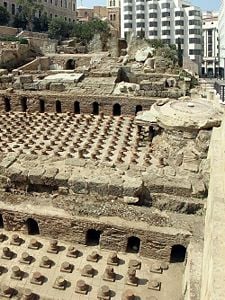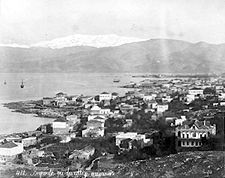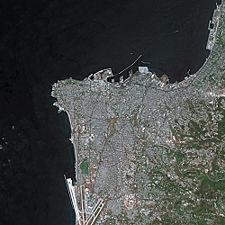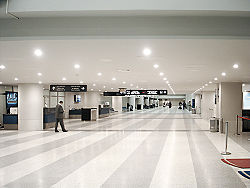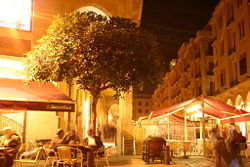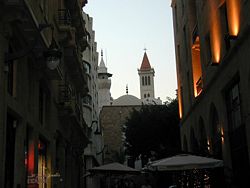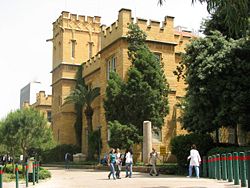Difference between revisions of "Beirut" - New World Encyclopedia
Mike Butler (talk | contribs) |
Rosie Tanabe (talk | contribs) |
||
| (132 intermediate revisions by 8 users not shown) | |||
| Line 1: | Line 1: | ||
| + | {{Images OK}}{{Submitted}}{{Approved}}{{copyedited}} | ||
{{Infobox Settlement | {{Infobox Settlement | ||
| − | |official_name = Beirut | + | |official_name=Beirut |
| − | |native_name = | + | |other_name=Beyrut<small>(Turkish)</small> |
| − | |other_name= | + | |native_name=بيروت ''Bayrūt'' |
| − | |image_skyline = Beirutcity.jpg | + | |other_name=Beyrouth <small>(French)</small> |
| − | |imagesize= | + | |city_motto=BERYTUS NUTRIX LEGUM ([[Latin]]) |
| − | |image_flag = | + | |image_skyline=Beirutcity.jpg |
| − | |image_seal = | + | |image_caption= |
| − | |image_map = | + | |imagesize=275px |
| − | |image_caption = | + | |image_flag= |
| − | |mapsize = | + | |image_seal= |
| − | |map_caption = Location in Lebanon. The surrounding district can be seen on the map. | + | |image_map= |
| − | |image_shield = | + | |image_caption= |
| − | |shield_size = | + | |mapsize=100 best |
| + | |map_caption=Location in Lebanon. The surrounding district can be seen on the map. | ||
| + | |image_shield= | ||
| + | |shield_size= | ||
|pushpin_map=Lebanon | |pushpin_map=Lebanon | ||
| − | |pushpin_mapsize= | + | |pushpin_mapsize=250 |
| − | |subdivision_type | + | |coordinates_region=LB |
| − | |subdivision_type1 = [[Governorates of Lebanon|Governorate]] | + | |subdivision_type=Country |
| − | |subdivision_name | + | |subdivision_type1=[[Governorates of Lebanon|Governorate]] |
| − | |subdivision_name1 = [[Beirut Governorate|Beirut, Capital City]] | + | |subdivision_name=[[Lebanon]] |
| − | |leader_title = | + | |subdivision_name1=[[Beirut Governorate|Beirut, Capital City]] |
| − | |leader_name = | + | |leader_title=Mayor |
| − | |area_note = | + | |leader_name=Jamal Itani |
| − | |area_magnitude = | + | |area_note= |
| − | |area_total_km2 = | + | |area_magnitude= |
| − | | | + | |area_total_km2 =19.8 |
| − | |area_land_km2 = | + | |area_urban_km2 = |
| − | |area_water_km2 = | + | |area_metro_km2 =67 |
| − | |population_as_of = | + | |area_land_km2= |
| − | | | + | |area_water_km2= |
| − | |population_metro = | + | |population_total = 361,366<ref>[http://data.un.org/Data.aspx?q=city+population&d=POP&f=tableCode%3a240 City population by sex, city and city type] ''United Nations Statistics Division'', February 12, 2020. Retrieved August 19, 2020.</ref> |
| − | + | | population_as_of = 2015 | |
| − | |timezone = +2 | + | | population_density_km2 = |
| − | |utc_offset = | + | | population_metro = 2,200,000<ref>[https://www.worldbank.org/en/news/feature/2014/09/30/questions-and-answers-water-supply-augmentation-project-lebanon Questions & Answers: Water Supply Augmentation Project, Lebanon] ''The World Bank'', September 30, 2014. Retrieved August 19, 2020.</ref> |
| − | |timezone_DST = +3 | + | |timezone=+2 |
| − | |utc_offset_DST = | + | |utc_offset= |
| − | |latd= 33|latm= 53|lats= | + | |timezone_DST=+3 |
| − | |longd= 35|longm= 30|longs= | + | |utc_offset_DST= |
| − | |elevation_m | + | |coordinates_display=inline,title |
| − | |elevation_ft | + | |latd=33|latm=53|lats=|latNS=N |
| − | + | |longd=35|longm=30|longs=|longEW=E | |
| − | + | |elevation_m= | |
| − | |website = [http://www.beirut.gov.lb City of Beirut] | + | |elevation_ft= |
| − | |footnotes = | + | |website=[http://www.beirut.gov.lb/ City of Beirut] |
| + | |footnotes= | ||
}} | }} | ||
| − | '''Beirut''' ({{lang-ar|بيروت}}, ''Bayrūt'' | + | '''Beirut''' ({{lang-ar|بيروت}}, ''Bayrūt,'' [[Greek language|Greek]]: Βηρυττός ''Viryttós,'' {{lang-fr|Beyrouth}}, [[Syriac language|Syriac]]: ܒܝܪܘܬ) is the capital and largest city of [[Lebanon]]. The first mention of the city is found in the [[ancient Egypt]]ian [[Tell el Amarna]] letters, dating to the fifteenth century B.C.E., and the city has been continuously inhabited over the centuries since. Excavations in the downtown area have unearthed layers of [[Phoenicia]]n, [[Hellenism|Hellenistic]], [[Ancient Rome|Roman]], [[Arab]], and [[Ottoman Empire|Ottoman]] remains. |
| − | + | Prior to 1975, the country was considered the banking capital of the [[Arab]] world and was widely known as the "[[Switzerland]] of the [[Middle East]]" due to numerous financial institutions based in Beirut. The city attracted large numbers of tourists, to the extent that it was referred to as the "[[Paris]] of the Middle East." During the [[Lebanese Civil War]] of 1975-1990 the city was divided between the largely [[Muslim]] west section and the [[Christian]] east. As a result of the civil war, the central area of the city, previously the focus of much of the commercial and cultural activity, became a desolate "no man's land." | |
| + | {{toc}} | ||
| + | After the long and destructive war, Beirut rebuilt itself, and the redesigned city center, marina, pubs, and nightlife districts have made it once again a popular tourist destination. Beirut holds Lebanon's seat of government and plays a central role in the Lebanese economy. It is renowned for its theaters and cultural centers. Beirut has kept pace to return to its former glory and it remains an important city in the Middle East, especially in terms of its tolerance and practice of [[freedom of the press]]. | ||
== Geography == | == Geography == | ||
[[Image:BeirutRaouche1.jpg|thumb|left|250px|Pigeons' Rock ([[Raouché]]).]] | [[Image:BeirutRaouche1.jpg|thumb|left|250px|Pigeons' Rock ([[Raouché]]).]] | ||
| − | [[ | + | Located on a [[peninsula]] that extends west at the midpoint of [[Lebanon]]'s coastline with the [[Mediterranean Sea]], Beirut serves as the country's main [[seaport]] and forms the Beirut District. Flanked by the Lebanon mountains, the city has taken on a triangular shape, largely influenced by its situation between and atop two hills: Al-Ashrafieh and Al-Musaytibah. Beirut's coast consists of rocky beaches, sandy shores, and cliffs. |
| − | |||
| − | + | The Beirut Governorate area covers 6.9 square miles (18 square kilometers), and the city's metropolitan area covers 26 square miles (67 square kilometers). | |
| − | + | Beirut has a [[Mediterranean climate]] characterized by a hot and humid [[summer]], pleasant autumn and spring, and a cool, rainy [[winter]]. August is the hottest month with an average high [[temperature]] of 85°F (29°C). January and February are the coldest months with an average low temperature of 50°F (10°C). During the afternoon and evening the prevailing wind direction is onshore, from the west, while at night the wind direction reverses to offshore, from the land. | |
| − | + | Winter is the [[rain]]y season, with most precipitation falling after December. The average annual rainfall is 34.1 inches (860 mm), falling in heavy cloudbursts in winter. | |
| − | + | [[Air pollution]] from car exhausts and private electricity generators, inadequate waste disposal, [[deforestation]], and excessive removal of beach sand are among environmental problems facing Beirut. | |
| − | |||
| − | |||
| − | |||
| + | == History == | ||
| + | [[Image:Beirut-Roman-Bath.jpg|right|thumb|225px|Roman baths in downtown Beirut.]] | ||
| + | [[Image:Beyrouth-histoire1.jpg|thumb|right|225px|Nineteenth century view of Beirut with snow-capped [[Mount Sannine]] in the background.]] | ||
| + | [[Image:Beirut SPOT 1113.jpg|thumb|225px|Beirut seen from SPOT satellite.]] | ||
| + | Originally named ''Bêrūt,'' ''The Wells,'' which refers to the underground [[water]] supply there, by the Phoenicians, Beirut's history goes back more than 5,000 years. Excavations in the downtown area have unearthed layers of [[Phoenicia]]n, [[Hellenism|Hellenistic]], [[Ancient Rome|Roman]], [[Arab]], and [[Ottoman Empire|Ottoman]] remains. | ||
| + | |||
| + | The first historical reference to Beirut dates from the fourteenth century B.C.E., when it was mentioned in the [[Cuneiform script|cuneiform]] tablets of the "[[Amarna letters]]," when [[Ammunira]] of Biruta (Beirut) sent three letters to the pharaoh of Egypt. Biruta is also referenced in the letters from [[Rib-Hadda]] of [[Byblos]]. The most ancient settlement was on an island in the river that progressively silted up. The city was known in antiquity as "Berytus." | ||
| + | |||
| + | In 140 B.C.E., [[Diodotus Tryphon]] seized and destroyed the city in his contest with [[Antiochus VII Sidetes]] for the throne of the [[Seleucid]] monarchy. Beirut was soon rebuilt on a more regular [[Hellenistic]] plan, renamed ''Laodicea in Phoenicia'' or ''Laodicea in Canaan,'' in honor of a Seleucid [[Laodice]]. | ||
| − | + | Mid-first century coins of Berytus bear the head of [[Tyche]], goddess of fortune. On the reverse, the city's symbol appears: a dolphin entwining an anchor. | |
| − | |||
| − | + | Beirut was conquered by [[Agrippa]] in 64 B.C.E. and the city was renamed in honor of the emperor's daughter, Julia; its full name became "Colonia Julia Augusta Felix Berytus." The veterans of two Roman legions were established in the city: The fifth Macedonian and the third Gallic. The city quickly became Romanized; large public buildings and monuments were erected and Berytus enjoyed full status as a part of the empire. | |
| − | + | Under the Romans, it was enriched by the dynasty of [[Herod the Great]] (73 B.C.E.-4 B.C.E.), and was made a ''colonia,'' | |
| − | + | "Colonia Iulia Augusta Felix Berytus," in 14 B.C.E. Beirut's School of Law was widely known at the time. Two of Rome's most famous jurists, [[Papinian]] and [[Ulpian]], both natives of Phoenicia, taught at the law school under the [[Severan]] emperors. | |
| − | |||
| − | |||
| − | |||
| − | |||
| − | |||
| − | |||
| − | |||
| − | |||
| − | |||
| − | |||
| − | |||
| − | |||
| − | |||
| − | |||
| − | |||
| − | |||
| − | |||
| − | |||
| − | |||
| − | |||
| − | |||
| − | |||
| − | |||
| − | |||
| − | |||
| − | |||
| − | |||
| − | |||
| − | |||
| − | |||
| − | |||
| − | |||
| − | |||
| − | |||
| − | |||
| − | |||
| − | |||
| − | |||
| − | |||
| − | |||
| − | |||
| − | |||
| − | |||
| − | |||
| − | |||
| − | + | When [[Justinian I|Justinian]] (483-565) assembled his [[Pandects]] in the sixth century, a large part of the corpus of laws were derived from these two jurists, and Justinian recognized the school as one of the three official law schools of the empire (533). Within a few years, as the result of a triple catastrophe of earthquake, tidal wave and fire (551), the students were transferred to [[Sidon]]. About 30,000 were killed in Berytus alone and, along the Phoenician coast total casualties were close to 250,000. | |
| − | + | ||
| + | Beirut passed to the [[Arab]]s in 635. As a trading center of the eastern [[Mediterranean]], Beirut was overshadowed by [[Acre (city)|Akka]] during the [[Middle Ages]]. | ||
| + | |||
| + | From 1110 to 1291, it was in the hands of the [[Crusades|Crusader]]s. No matter who was its nominal overlord, whether Turk or [[Mamluk]], Beirut was ruled locally by [[Druze]] emirs. One of these, [[Fakr ed-Din Maan II]] (1572-1635), fortified it early in the seventeenth century. | ||
| + | |||
| + | The [[Ottoman Empire|Ottomans]] retook it in 1763 and thenceforth, with the help of [[Damascus]], Beirut successfully broke Akka's monopoly on Syrian maritime trade and for a few years supplanted it as the main trading center in the region. | ||
| + | |||
| + | During the succeeding epoch of rebellion against Ottoman hegemony at Akka under [[Jezzar Pasha|Jezzar]] (1720-1804) and [[Abdullah Pasha|Abdullah]] pashas, Beirut declined to a small town (population about 10,000), and was fought over among the Druze, the Turks, and the pashas. | ||
| + | |||
| + | After [[Ibrahim Pasha]] (1789–1848) captured Akka in 1832, Beirut began its early modern revival. In 1888, Beirut was made capital of a [[vilayet]] in Syria, including the [[sanjak]]s Latakia, [[Tripoli, Lebanon|Tripoli]], Beirut, Akka and Bekaa. Beirut became a cosmopolitan city and had close links with [[Europe]] and the [[United States]]. | ||
| + | |||
| + | Beirut became a center of [[missionary]] activity, which was generally unsuccessful in conversions (a massacre of Christians in 1860 was the occasion for further European interventions), but did build an impressive [[education]] system. This included the Syrian Protestant College, which was established by American missionaries and eventually became the American University of Beirut. | ||
| + | |||
| + | Beirut became the center of Arab intellectual activity in the nineteenth century. Provided with [[water]] from a British company and gas from a French one, the city thrived on exporting [[silk]] grown on nearby Mount Lebanon. | ||
| + | |||
| + | After French engineers established a modern harbor in 1894, and a rail link across Lebanon to [[Damascus]], and then to [[Aleppo]] in 1907, much of the trade was carried by [[France|French]] ships to [[Marseille]], and soon French influence in the area exceeded that of any other [[Europe]]an power. In 1911, the population mix was reported as Muslims, 36,000; Christians, 77,000; Jews, 2500; Druze, 400; foreigners, 4100. | ||
| + | |||
| + | After the collapse of the Ottoman Empire following [[World War I]] (1914-1918), Beirut, along with all of Lebanon was placed under the [[French Mandate of Lebanon|French Mandate]]. | ||
| + | |||
| + | [[Lebanon]] achieved independence in 1943, and Beirut became its capital city and remained the intellectual capital of the Arab world, and a major commercial and tourist center, until 1975, when a brutal [[civil war]] broke out in the country. | ||
| − | In | + | In response to an attack on an [[El Al]] jet in [[Athens]] on the night of December 28, 1968, [[Israel]]i commandos mounted a surprise attack on the airport and destroyed 13 civilian aircraft belonging to the Lebanese carrier, Middle East Airlines. |
| − | + | During most of the war, the city was divided between the largely [[Muslim]] west section and the [[Christian]] east. The central area of the city, previously the focus of much of the commercial and cultural activity, became a "no man's land." Many of the city's inhabitants fled to other countries. In 1983, [[France|French]] and [[U.S.]] barracks were bombed, killing 58 French and 241 American servicemen. | |
| − | |||
| − | |||
| − | + | Since the end of the war in 1990, the people of Lebanon have been rebuilding Beirut, and by the beginning of the [[2006 Israel-Lebanon conflict]] the city had somewhat regained its status as a [[tourism|tourist]], cultural, and intellectual center in the [[Middle East]], as well as a center for commerce, fashion, and media. However, many would say the city has lost its premier status, due to competition from places such as [[Dubai]] and [[Cyprus]] in the fields of tourism, business, fashion, commerce, and banking. Reconstruction of downtown Beirut has been largely driven by [[Solidere]], a development company established in 1994 by [[Rafik Hariri]]. | |
| − | |||
| − | |||
| − | |||
| − | |||
| − | |||
| − | + | The 2005 assassination of former Lebanese Prime Minister Rafik Hariri near the [[Saint George Bay]] in Beirut shook the entire country. Approximately one million people gathered for an opposition rally in Beirut a month following his death. The "Cedar Revolution" was the largest rally in Lebanon's history. The last Syrian troops withdrew from Beirut on April 26, 2005. | |
| − | |||
| − | |||
| − | + | During the 2006 Lebanon War, Israeli bombardment caused damage in many parts of Beirut, especially the predominantly [[Shiite]] southern suburbs of Beirut. | |
| + | On August 4, 2020, multiple, massive explosions in the Port of Beirut resulted in the major damage and the death of at least 220 people and the wounding of more than 6,000. As many as 300,000 people were left homeless by the explosions. | ||
| − | + | Since the modern [[city]] overlies the ancient one, little [[archaeology]] had been done until after the end of the civil war in 1991. A dig in 1994 established that one of Beirut's modern streets, Souk Tawile, follows the lines of an ancient Hellenistic/Roman street. | |
| − | |||
| − | |||
| − | |||
| − | |||
| − | |||
| − | |||
| − | |||
| − | |||
| − | |||
| − | |||
| − | |||
| − | |||
| − | |||
| − | |||
| − | |||
| − | |||
| − | |||
| − | |||
| − | |||
| − | |||
| − | |||
| − | |||
| − | |||
| − | |||
| − | |||
| − | |||
| − | |||
| − | |||
| − | |||
| − | |||
| − | |||
| − | |||
| − | |||
| − | |||
| − | |||
| − | |||
| − | |||
| − | |||
| − | |||
| − | |||
| − | |||
| − | |||
| − | |||
| − | |||
| − | |||
| − | |||
| − | |||
| − | |||
| − | |||
| − | |||
| − | |||
| − | |||
| − | |||
| − | |||
| − | |||
| − | |||
| − | |||
| − | |||
| − | |||
| − | |||
| − | |||
| − | |||
| − | |||
| − | |||
| − | |||
| − | |||
| − | |||
| − | |||
| − | |||
| − | |||
| − | |||
| − | |||
| − | |||
| − | |||
| − | |||
| − | |||
| − | |||
| − | |||
| − | + | [[Image:Beirut Panorama.png|center|thumb|775px|Panoramic view of Beirut]] | |
| − | |||
| − | |||
| − | |||
| − | |||
| − | |||
| − | |||
| − | |||
| − | |||
| − | |||
| − | |||
| − | |||
| − | |||
| − | |||
| − | |||
| − | |||
| − | |||
| − | |||
| − | The | + | ==Government== |
| + | The Lebanese Republic has a parliamentary democracy in which the highest offices are proportionately reserved for representatives from various religious communities to minimize sectarian conflict—a framework known as “confessionalism.” The chief of state is the president, who is elected by the National Assembly for a six-year term. The head of government is the prime minister, who, with the deputy prime minister, is appointed by the president in consultation with the 128-seat [[National Assembly]]. | ||
| − | + | The [[Beirut Governorate|Beirut]] is one of six ''mohafazah'' (state governorates; mohafazat, singular), with the others being [[Beqaa Governorate|Beqaa]], [[North Governorate|North Lebanon]], [[South Governorate|South Lebanon]], [[Mount Lebanon Governorate|Mount Lebanon]], and [[Nabatiye Governorate|Nabatiye]]. | |
| − | |||
| − | [[ | ||
| − | |||
| − | + | Beirut is divided into 12 neighborhoods. These are: Ashrafieh, Beshoura, Dar el Mreyseh, Marfa’, Mazra’a, Mdawar, Mina El Hosson, Msaytbeh, Ras Beirut, Rmeil, Saifi, and Zkak El Blat. | |
| − | + | Four of the 12 official [[Palestinian refugee camps]] in Lebanon are located in Beirut. These are: [[Burj el-Barajneh]], Dbayeh, [[Mar Elias]], and [[Shatila]]. Of the 15 unregistered or unofficial refugee camps, Sabra, which lies adjacent to Shatila, is located in Beirut. | |
| − | + | The city is home to numerous international organizations. The [[United Nations]] [[ESCWA|Economic and Social Commission for Western Asia]] (ESCWA) is headquartered in Downtown Beirut, while the [[International Labour Organization]] (ILO) and [[UNESCO]] (United Nations Educational, Scientific and Cultural Organization) both have regional offices in Beirut covering the [[Arab world]]. The [[Arab Air Carriers Organization]] (AACO) is also headquartered in Beirut. | |
| + | <center><gallery> | ||
| + | Image:Beirut city hall.jpg|Facade of the Beirut City Hall | ||
| + | Image:UNbeirut.jpg|United Nations headquarters in Beirut | ||
| + | Image:Grand serail solidere 4.jpg|The Grand Serail | ||
| + | Image:BeirutParliament.jpg|Lebanese House of Speakers | ||
| + | </gallery></center> | ||
| − | == | + | == Economy == |
| − | [[Image: | + | [[Image:Beirutairport.jpg|thumb|right|250px|Inside the Beirut International Airport]] |
| − | [[Image: | + | [[Image:Beirut Downtown.jpg|thumb|right|250px|Downtown Beirut]] |
| − | + | Beirut was the economic, social, intellectual, and cultural hub of the Arab [[Middle East]] from 1952 until 1975. The city was [[banking]] center for [[Arab]] wealth, and the port was a leading entrepôt for the region. Beirut had a busy tourist industry, and numerous uncensored newspapers kept the Arab world informed. | |
| + | But the 1975-1990 [[civil war]] seriously damaged Lebanon's economic infrastructure, cut national output by half, and all but ended Lebanon's position. In the years since, Lebanon has rebuilt much of its war-torn physical and financial infrastructure by borrowing heavily—mostly from domestic banks. The Israeli-Hizballah conflict in July-August 2006 caused an estimated $3.6 billion in infrastructure damage, and prompted international donors to pledge nearly $1 billion in recovery and reconstruction assistance. | ||
| − | + | Lebanon has a competitive and free market regime and a strong laissez-faire commercial tradition. Private property is common and encouraged, while the government owns most public services. Land laws resemble those in [[France]] and the [[United States]]. The Lebanese economy is service-oriented; main growth sectors include [[banking]] and [[tourism]]. Beirut is the main center for newspaper and book publishing industries, and for [[satellite television]] stations, such as LBC, Future TV, New TV, and others. | |
| − | |||
| − | |||
| − | + | Dubbed “Paris of the East,” there is plenty of sightseeing, shopping, cuisine, and nightlife for tourists. Lebanon's capital city has been described as a vibrant, stylish metropolis, with sleek, modern buildings alongside arabesque Ottoman and French-style buildings. | |
| − | + | Before the war broke out in Lebanon in 2006, Travel and Leisure Magazine's [[World Best Awards 2006]] ranked Beirut as ninth best city in the world, falling just short of [[New York City]] and coming ahead of [[San Francisco]]. | |
| − | + | Per capita GDP was $6681 in 2006, giving Lebanon a rank of 90 on a list of 181 countries. The [[unemployment]] rate was 20 percent in 2006. | |
| − | The | + | The Beirut Rafic Hariri International Airport, which was opened in 1954, is located 5.6 miles (9 km) from the city center in the southern suburbs. It is the only operational commercial airport in the country, and is the hub for Lebanon's national carrier, [[Middle East Airlines]]. Beirut has a world-class facility which is ranked among the top airports in the Middle East. It is the main [[port of entry]] into the country along with the [[Port of Beirut]]. |
| − | + | Beirut has [[taxicab]]s, [[service taxi]]s, and publicly owned buses, and has bus connections to other cities in Lebanon as well as to cities in [[Syria]]. | |
| − | Beirut | + | ==Demographics== |
| + | [[Image:Beirut Mosque Church.jpg|thumb|right|250px|Mosque and Church in downtown Beirut.]] | ||
| + | [[Image:American University of beirut3.jpg|right|250px|thumb|The museum of the [[American University of Beirut]].]] | ||
| + | There are wide-ranging estimates of Beirut's [[population]], from as low as 938,940 people,<ref>''United Nations Statistics Division,'' [https://unstats.un.org/unsd/demographic/products/dyb/DYB2003/Table08.pdf Population of capital cities and cities of 100,000 and more inhabitants.] Retrieved August 19, 2020.</ref> to 1,303,129 people, to as high as 2,012,000.<ref>''Encyclopedia of the Nations,'' [http://www.nationsencyclopedia.com/Asia-and-Oceania/Lebanon-POPULATION.html Lebanon Population.] Retrieved August 19, 2020.</ref> The lack of an exact figure is due to the fact that no population census has been taken in Lebanon since 1932. | ||
| − | + | [[Arab]]s make up 95 percent of the population, [[Armenia]]ns four percent, others one percent. | |
| − | + | Arabs reached Lebanon in the seventh century, and their [[culture]] was superimposed on an already diverse ethnic population. Many Christian Lebanese do not identify themselves as Arab, but rather as descendants of the ancient [[Canaan]]ites and prefer to be called Phoenicians. | |
| − | + | Lebanon's official [[language]] is [[Arabic language|Arabic]], but [[French language|French]], [[Armenian language|Armenian]], and [[English language|English]] are widely spoken. Many Lebanese speak a patois of some combination of these four languages, most commonly an Arabic-French mixture. Virtually all Lebanese are bilingual. | |
| − | |||
| − | |||
| − | [[ | ||
| − | |||
| − | |||
| − | |||
| − | |||
| − | |||
| − | + | Beirut is one of the most [[Religion|religiously]] diverse cities of the [[Middle East]], and the city has had a history of political strife due to a roughly even division between Christians and Muslims. The nine major religious sects there are ([[Sunni Islam|Sunni Muslim]], [[Shia Islam|Shiite Muslim]], [[Druze]], [[Maronite|Maronite Catholic]], [[Greek Orthodox Church|Greek Orthodox]], [[Greek Catholic]], [[Armenian Orthodox]], [[Armenian Catholic]], and [[Protestant]]). Several decades ago, Beirut was home to a [[Jewish]] community, in Wadi Abu Jamil neighborhood. | |
| − | Beirut is the | ||
| − | + | Religious authorities handle [[marriage]], [[divorce]], and [[inheritance]]. Calls for civil marriage have been rejected, although foreign civil marriages are recognized. | |
| − | [[ | ||
| − | |||
| − | + | The [[Lebanese University]] is the only public tertiary institution in Beirut, which is home to some of the most well-renowned universities in the Middle East, such as the [[American University of Beirut]], [[Université Saint-Joseph]], [[Haigazian University]], and the [[Lebanese American University]]. | |
| − | + | Famous private schools include the [[International College]], the [[American Community School at Beirut|American Community School]], the Collège Protestant Français, the Collège Louise Wegman, and the [[Grand Lycée Franco-Libanais]]. | |
| − | + | The higher education system is based on the Baccalauréat libanais, but the Baccalauréat Français is accepted as an equivalent. Before being admitted to any higher education institution, one must achieve his or her Baccalauréat examinations. | |
| − | + | ==Society and culture== | |
| + | Atmosphere is what Beirut delivers best. Its mix of peoples, [[religion]]s, and [[culture]]s gives the city a dynamic edge. There are hundreds of [[art]] galleries there, and the city is home to more than 5,000 artists working in fine arts, [[music]], design, [[architecture]], [[theater]], [[film]], and [[photography]]. Beirut is home to international [[fashion design]]ers such as Elie Saab, Zuhair Murad, and Georges Chakra, and [[jewelry|jeweler]] Robert Moawad. | ||
| − | Beirut | + | The Beirut Nights events take place in the city, usually in the summer, often in the [[Beirut Central District]], which attracts large numbers of people of different nationalities. Performances include [[classical music]], [[dance]], [[theater]], [[opera]], [[jazz]], and modern world music. Places of interest include: |
| − | + | * The Corniche, a long seaside promenade, which is a public gathering space with wonderful views of the coast. | |
| − | + | * Pigeon Rocks, rock formations in a cove in Raouche. | |
| + | * The Grand Serail, also known as the Government Palace, which is the headquarters of the Prime Minister of Lebanon. It is situated atop a hill in downtown Beirut a few blocks away from the Lebanese Parliament. An historic building, it is the most important of three Ottoman monuments on the hill—the other two are the Council for Development and Reconstruction and the Hamidiyyeh clock tower. | ||
| + | * The St. George Greek Orthodox Cathedral, and the St. George Maronite Cathedral. | ||
| + | * The Roman Baths, and other downtown archaeological sites, which are being restored for public viewing. | ||
| + | * The National Museum, which is the principal [[museum]] of [[archaeology]] in [[Lebanon]]. About 1,300 artifacts are exhibited, ranging from prehistoric times to the medieval Mamluk period. During the 1975 Lebanese Civil War, the museum stood on the front line that separated the warring factions. | ||
| + | * The smaller American University of Beirut Archaeology Museum, which is the third oldest museum in the Middle East, it exhibits a wide range of artifacts from Lebanon and neighboring countries. | ||
| + | * The Sursock Museum, which was built by the [[Sursock]] family at the end of the nineteenth century as a private villa, occasionally displays antiquities, but its primary focus is on contemporary Lebanese art. | ||
| + | * Ashrafieh, where the Sursock Museum is located, is a neighborhood with narrow, winding streets and some beautiful old residences. | ||
| + | * Hamra, south of the American University, is a good place to soak up the city's daily life. | ||
| − | + | == Looking to the future == | |
| + | Beirut was once considered the most Westernized city in the Arab [[Middle East]], and its hub of economic, social, intellectual, and cultural life. However, it was ravaged by a 15 year long [[civil war]] (1975-1990) from which it has not fully recovered. | ||
| − | + | Prior to the war, foreign [[banking]] and business firms favored Beirut as a base for their Middle East operations. It was considered a liberal city in a liberal country, in the midst of nations ruled by authoritarian or militarist regimes. | |
| − | |||
| − | + | Lebanon's ending to its civil war did not mean an end of strife. Beirut attracted Palestinian resistance organizations in the latter half of the 1960s and became headquarters to the [[Palestine Liberation Organization]] (PLO) in 1970. Israeli troops trapped the PLO in the city in 1982, requiring intercession by multinational forces. Still violence continued and Beirut was essentially a warzone, causing many residents and businesses to leave the city. | |
| − | + | Since 1990, the city has made extensive reconstruction efforts to restore its infrastructure, economic base, and historic landmarks. Prior to the war, Beirut was a popular tourist destination and is becoming so again in the early years of the twenty-first century. Headway has been made within the economic sector—''[[Travel and Leisure Magazine]]'s'' World Best Awards 2006 ranked Beirut as ninth best city in the world, falling just short of [[New York City]] and coming ahead of [[San Francisco]]. However, this was prior to the 2006 Israel-Lebanon conflict. Recurring instability no doubt hampers the city's efforts at regaining its previous glory. In addition, there is now competition from places such as [[Dubai]] and [[Cyprus]] in the fields of [[tourism]], business, [[fashion]], commerce, and banking. However, the air of tolerance in Beirut is a strong asset. While censorship of the press is strong in many Middle Eastern countries, it enjoys [[freedom of the press|freedom]] in Lebanon. Catering to the Arab world at large, Lebanese printing actually expanded during the war years to become one of the country’s major industries. | |
| − | |||
| − | |||
| − | |||
| − | |||
| − | |||
| − | |||
| − | |||
| − | |||
| − | |||
| − | |||
| − | |||
| − | |||
| − | |||
| − | |||
| − | |||
| − | |||
| − | |||
| − | |||
| − | |||
| − | |||
| − | |||
| − | + | No doubt Beirut will remain an important city within Lebanon, and to the larger world in some respects, however its years of war have taken its toll and it is not likely to return to the position it once held. | |
| − | <gallery> | + | <center><gallery> |
| − | |||
| − | |||
| − | |||
| − | |||
Image:Beirut sunset(5).jpg|[[Raouché]] | Image:Beirut sunset(5).jpg|[[Raouché]] | ||
Image:Beirut corniche.jpg|[[Corniche|Corniche Beirut]] | Image:Beirut corniche.jpg|[[Corniche|Corniche Beirut]] | ||
Image:Beirut-Sannine.jpg|Beirut Sannine | Image:Beirut-Sannine.jpg|Beirut Sannine | ||
Image:Saifivillage.JPG|[[Beirut Central District|Saifi village]] | Image:Saifivillage.JPG|[[Beirut Central District|Saifi village]] | ||
| − | </gallery> | + | </gallery></center> |
| − | == | + | ==Notes== |
| − | + | <references/> | |
| − | |||
==References== | ==References== | ||
| − | {{ | + | * El-Rayes, Nathalie Antoine. ''The Role of the Port of Beirut in the Lebanese Economy: Past Performance and Future Development''. Beirut: American University of Beirut, 1997. {{OCLC|43318041}} |
| + | * ''Encyclopædia Britannica Online''. [http://www.britannica.com/EBchecked/topic/58884/Beirut#tab=active~checked%2Citems~checked&title=Beirut%20—%20Britannica%20Online%20Encyclopedia.htm Beirut.] Retrieved August 19, 2020. | ||
| + | * Hall, Linda Jones. ''Roman Berytus Beirut in Late Antiquity''. London: Routledge, 2004. | ||
| + | * Jehl, Douglas. [http://query.nytimes.com/gst/fullpage.html?res=9404E2D9103EF930A15751C0A961958260 Under Beirut's Rubble, Remnants of 5000 Years of Civilization.] ''The New York Times'', February 23, 1997. Retrieved August 19, 2020. | ||
| + | * Jidejian, Nina. ''Beirut Through the Ages''. Beirut: Dar el-Machreq, 1973. {{OCLC|1053364}} | ||
| + | * ''Lebanese Embassy of the U.S.'' Profile of Lebanon: History. | ||
| + | * McPherson, Larry E. ''Beirut City Center''. Göttingen: Steidl, 2006. ISBN 978-3865212184 | ||
| + | * Salti, R., and G. Sholette. "Report from Beirut: Days of Culture, Days of Siege." ''Afterimage'' 34(1/2) (2006): 10-13. | ||
| + | * Talbert, Richard J. A., and Roger S. Bagnall. ''Barrington Atlas of the Greek and Roman World.'' Princeton, NJ: Princeton University Press, 2000. ISBN 978-0691031699 | ||
| + | * Ṭarābulsī, Fawwāz. ''A History of Modern Lebanon''. London: Pluto, 2007. ISBN 978-0745324388 | ||
| + | |||
| − | |||
| − | |||
| − | |||
| − | |||
| − | |||
| − | |||
| − | |||
| − | |||
| − | |||
| − | |||
| − | |||
| − | |||
| − | |||
[[Category:Geography]] | [[Category:Geography]] | ||
[[Category:Cities]] | [[Category:Cities]] | ||
| + | [[Category:Middle East]] | ||
{{credit|Beirut|227506186|}} | {{credit|Beirut|227506186|}} | ||
Latest revision as of 18:41, 11 January 2023
| Beirut بيروت Bayrūt Beyrouth (French) |
|
| Location in Lebanon. The surrounding district can be seen on the map. | |
| Coordinates: 33°53′N 35°30′E | |
|---|---|
| Country | Lebanon |
| Governorate | Beirut, Capital City |
| Government | |
| - Mayor | Jamal Itani |
| Area | |
| - City | 19.8 km² (7.6 sq mi) |
| - Metro | 67 km² (25.9 sq mi) |
| Population (2015) | |
| - City | 361,366[2] |
| - Metro | 2,200,000[1] |
| Time zone | +2 (UTC) |
| - Summer (DST) | +3 (UTC) |
| Website: City of Beirut | |
Beirut (Arabic: بيروت, Bayrūt, Greek: Βηρυττός Viryttós, French: Beyrouth, Syriac: ܒܝܪܘܬ) is the capital and largest city of Lebanon. The first mention of the city is found in the ancient Egyptian Tell el Amarna letters, dating to the fifteenth century B.C.E., and the city has been continuously inhabited over the centuries since. Excavations in the downtown area have unearthed layers of Phoenician, Hellenistic, Roman, Arab, and Ottoman remains.
Prior to 1975, the country was considered the banking capital of the Arab world and was widely known as the "Switzerland of the Middle East" due to numerous financial institutions based in Beirut. The city attracted large numbers of tourists, to the extent that it was referred to as the "Paris of the Middle East." During the Lebanese Civil War of 1975-1990 the city was divided between the largely Muslim west section and the Christian east. As a result of the civil war, the central area of the city, previously the focus of much of the commercial and cultural activity, became a desolate "no man's land."
After the long and destructive war, Beirut rebuilt itself, and the redesigned city center, marina, pubs, and nightlife districts have made it once again a popular tourist destination. Beirut holds Lebanon's seat of government and plays a central role in the Lebanese economy. It is renowned for its theaters and cultural centers. Beirut has kept pace to return to its former glory and it remains an important city in the Middle East, especially in terms of its tolerance and practice of freedom of the press.
Geography
Located on a peninsula that extends west at the midpoint of Lebanon's coastline with the Mediterranean Sea, Beirut serves as the country's main seaport and forms the Beirut District. Flanked by the Lebanon mountains, the city has taken on a triangular shape, largely influenced by its situation between and atop two hills: Al-Ashrafieh and Al-Musaytibah. Beirut's coast consists of rocky beaches, sandy shores, and cliffs.
The Beirut Governorate area covers 6.9 square miles (18 square kilometers), and the city's metropolitan area covers 26 square miles (67 square kilometers).
Beirut has a Mediterranean climate characterized by a hot and humid summer, pleasant autumn and spring, and a cool, rainy winter. August is the hottest month with an average high temperature of 85°F (29°C). January and February are the coldest months with an average low temperature of 50°F (10°C). During the afternoon and evening the prevailing wind direction is onshore, from the west, while at night the wind direction reverses to offshore, from the land.
Winter is the rainy season, with most precipitation falling after December. The average annual rainfall is 34.1 inches (860 mm), falling in heavy cloudbursts in winter.
Air pollution from car exhausts and private electricity generators, inadequate waste disposal, deforestation, and excessive removal of beach sand are among environmental problems facing Beirut.
History
Originally named Bêrūt, The Wells, which refers to the underground water supply there, by the Phoenicians, Beirut's history goes back more than 5,000 years. Excavations in the downtown area have unearthed layers of Phoenician, Hellenistic, Roman, Arab, and Ottoman remains.
The first historical reference to Beirut dates from the fourteenth century B.C.E., when it was mentioned in the cuneiform tablets of the "Amarna letters," when Ammunira of Biruta (Beirut) sent three letters to the pharaoh of Egypt. Biruta is also referenced in the letters from Rib-Hadda of Byblos. The most ancient settlement was on an island in the river that progressively silted up. The city was known in antiquity as "Berytus."
In 140 B.C.E., Diodotus Tryphon seized and destroyed the city in his contest with Antiochus VII Sidetes for the throne of the Seleucid monarchy. Beirut was soon rebuilt on a more regular Hellenistic plan, renamed Laodicea in Phoenicia or Laodicea in Canaan, in honor of a Seleucid Laodice.
Mid-first century coins of Berytus bear the head of Tyche, goddess of fortune. On the reverse, the city's symbol appears: a dolphin entwining an anchor.
Beirut was conquered by Agrippa in 64 B.C.E. and the city was renamed in honor of the emperor's daughter, Julia; its full name became "Colonia Julia Augusta Felix Berytus." The veterans of two Roman legions were established in the city: The fifth Macedonian and the third Gallic. The city quickly became Romanized; large public buildings and monuments were erected and Berytus enjoyed full status as a part of the empire.
Under the Romans, it was enriched by the dynasty of Herod the Great (73 B.C.E.-4 B.C.E.), and was made a colonia, "Colonia Iulia Augusta Felix Berytus," in 14 B.C.E. Beirut's School of Law was widely known at the time. Two of Rome's most famous jurists, Papinian and Ulpian, both natives of Phoenicia, taught at the law school under the Severan emperors.
When Justinian (483-565) assembled his Pandects in the sixth century, a large part of the corpus of laws were derived from these two jurists, and Justinian recognized the school as one of the three official law schools of the empire (533). Within a few years, as the result of a triple catastrophe of earthquake, tidal wave and fire (551), the students were transferred to Sidon. About 30,000 were killed in Berytus alone and, along the Phoenician coast total casualties were close to 250,000.
Beirut passed to the Arabs in 635. As a trading center of the eastern Mediterranean, Beirut was overshadowed by Akka during the Middle Ages.
From 1110 to 1291, it was in the hands of the Crusaders. No matter who was its nominal overlord, whether Turk or Mamluk, Beirut was ruled locally by Druze emirs. One of these, Fakr ed-Din Maan II (1572-1635), fortified it early in the seventeenth century.
The Ottomans retook it in 1763 and thenceforth, with the help of Damascus, Beirut successfully broke Akka's monopoly on Syrian maritime trade and for a few years supplanted it as the main trading center in the region.
During the succeeding epoch of rebellion against Ottoman hegemony at Akka under Jezzar (1720-1804) and Abdullah pashas, Beirut declined to a small town (population about 10,000), and was fought over among the Druze, the Turks, and the pashas.
After Ibrahim Pasha (1789–1848) captured Akka in 1832, Beirut began its early modern revival. In 1888, Beirut was made capital of a vilayet in Syria, including the sanjaks Latakia, Tripoli, Beirut, Akka and Bekaa. Beirut became a cosmopolitan city and had close links with Europe and the United States.
Beirut became a center of missionary activity, which was generally unsuccessful in conversions (a massacre of Christians in 1860 was the occasion for further European interventions), but did build an impressive education system. This included the Syrian Protestant College, which was established by American missionaries and eventually became the American University of Beirut.
Beirut became the center of Arab intellectual activity in the nineteenth century. Provided with water from a British company and gas from a French one, the city thrived on exporting silk grown on nearby Mount Lebanon.
After French engineers established a modern harbor in 1894, and a rail link across Lebanon to Damascus, and then to Aleppo in 1907, much of the trade was carried by French ships to Marseille, and soon French influence in the area exceeded that of any other European power. In 1911, the population mix was reported as Muslims, 36,000; Christians, 77,000; Jews, 2500; Druze, 400; foreigners, 4100.
After the collapse of the Ottoman Empire following World War I (1914-1918), Beirut, along with all of Lebanon was placed under the French Mandate.
Lebanon achieved independence in 1943, and Beirut became its capital city and remained the intellectual capital of the Arab world, and a major commercial and tourist center, until 1975, when a brutal civil war broke out in the country.
In response to an attack on an El Al jet in Athens on the night of December 28, 1968, Israeli commandos mounted a surprise attack on the airport and destroyed 13 civilian aircraft belonging to the Lebanese carrier, Middle East Airlines.
During most of the war, the city was divided between the largely Muslim west section and the Christian east. The central area of the city, previously the focus of much of the commercial and cultural activity, became a "no man's land." Many of the city's inhabitants fled to other countries. In 1983, French and U.S. barracks were bombed, killing 58 French and 241 American servicemen.
Since the end of the war in 1990, the people of Lebanon have been rebuilding Beirut, and by the beginning of the 2006 Israel-Lebanon conflict the city had somewhat regained its status as a tourist, cultural, and intellectual center in the Middle East, as well as a center for commerce, fashion, and media. However, many would say the city has lost its premier status, due to competition from places such as Dubai and Cyprus in the fields of tourism, business, fashion, commerce, and banking. Reconstruction of downtown Beirut has been largely driven by Solidere, a development company established in 1994 by Rafik Hariri.
The 2005 assassination of former Lebanese Prime Minister Rafik Hariri near the Saint George Bay in Beirut shook the entire country. Approximately one million people gathered for an opposition rally in Beirut a month following his death. The "Cedar Revolution" was the largest rally in Lebanon's history. The last Syrian troops withdrew from Beirut on April 26, 2005.
During the 2006 Lebanon War, Israeli bombardment caused damage in many parts of Beirut, especially the predominantly Shiite southern suburbs of Beirut.
On August 4, 2020, multiple, massive explosions in the Port of Beirut resulted in the major damage and the death of at least 220 people and the wounding of more than 6,000. As many as 300,000 people were left homeless by the explosions.
Since the modern city overlies the ancient one, little archaeology had been done until after the end of the civil war in 1991. A dig in 1994 established that one of Beirut's modern streets, Souk Tawile, follows the lines of an ancient Hellenistic/Roman street.
Government
The Lebanese Republic has a parliamentary democracy in which the highest offices are proportionately reserved for representatives from various religious communities to minimize sectarian conflict—a framework known as “confessionalism.” The chief of state is the president, who is elected by the National Assembly for a six-year term. The head of government is the prime minister, who, with the deputy prime minister, is appointed by the president in consultation with the 128-seat National Assembly.
The Beirut is one of six mohafazah (state governorates; mohafazat, singular), with the others being Beqaa, North Lebanon, South Lebanon, Mount Lebanon, and Nabatiye.
Beirut is divided into 12 neighborhoods. These are: Ashrafieh, Beshoura, Dar el Mreyseh, Marfa’, Mazra’a, Mdawar, Mina El Hosson, Msaytbeh, Ras Beirut, Rmeil, Saifi, and Zkak El Blat.
Four of the 12 official Palestinian refugee camps in Lebanon are located in Beirut. These are: Burj el-Barajneh, Dbayeh, Mar Elias, and Shatila. Of the 15 unregistered or unofficial refugee camps, Sabra, which lies adjacent to Shatila, is located in Beirut.
The city is home to numerous international organizations. The United Nations Economic and Social Commission for Western Asia (ESCWA) is headquartered in Downtown Beirut, while the International Labour Organization (ILO) and UNESCO (United Nations Educational, Scientific and Cultural Organization) both have regional offices in Beirut covering the Arab world. The Arab Air Carriers Organization (AACO) is also headquartered in Beirut.
Economy
Beirut was the economic, social, intellectual, and cultural hub of the Arab Middle East from 1952 until 1975. The city was banking center for Arab wealth, and the port was a leading entrepôt for the region. Beirut had a busy tourist industry, and numerous uncensored newspapers kept the Arab world informed.
But the 1975-1990 civil war seriously damaged Lebanon's economic infrastructure, cut national output by half, and all but ended Lebanon's position. In the years since, Lebanon has rebuilt much of its war-torn physical and financial infrastructure by borrowing heavily—mostly from domestic banks. The Israeli-Hizballah conflict in July-August 2006 caused an estimated $3.6 billion in infrastructure damage, and prompted international donors to pledge nearly $1 billion in recovery and reconstruction assistance.
Lebanon has a competitive and free market regime and a strong laissez-faire commercial tradition. Private property is common and encouraged, while the government owns most public services. Land laws resemble those in France and the United States. The Lebanese economy is service-oriented; main growth sectors include banking and tourism. Beirut is the main center for newspaper and book publishing industries, and for satellite television stations, such as LBC, Future TV, New TV, and others.
Dubbed “Paris of the East,” there is plenty of sightseeing, shopping, cuisine, and nightlife for tourists. Lebanon's capital city has been described as a vibrant, stylish metropolis, with sleek, modern buildings alongside arabesque Ottoman and French-style buildings.
Before the war broke out in Lebanon in 2006, Travel and Leisure Magazine's World Best Awards 2006 ranked Beirut as ninth best city in the world, falling just short of New York City and coming ahead of San Francisco.
Per capita GDP was $6681 in 2006, giving Lebanon a rank of 90 on a list of 181 countries. The unemployment rate was 20 percent in 2006.
The Beirut Rafic Hariri International Airport, which was opened in 1954, is located 5.6 miles (9 km) from the city center in the southern suburbs. It is the only operational commercial airport in the country, and is the hub for Lebanon's national carrier, Middle East Airlines. Beirut has a world-class facility which is ranked among the top airports in the Middle East. It is the main port of entry into the country along with the Port of Beirut.
Beirut has taxicabs, service taxis, and publicly owned buses, and has bus connections to other cities in Lebanon as well as to cities in Syria.
Demographics
There are wide-ranging estimates of Beirut's population, from as low as 938,940 people,[3] to 1,303,129 people, to as high as 2,012,000.[4] The lack of an exact figure is due to the fact that no population census has been taken in Lebanon since 1932.
Arabs make up 95 percent of the population, Armenians four percent, others one percent. Arabs reached Lebanon in the seventh century, and their culture was superimposed on an already diverse ethnic population. Many Christian Lebanese do not identify themselves as Arab, but rather as descendants of the ancient Canaanites and prefer to be called Phoenicians.
Lebanon's official language is Arabic, but French, Armenian, and English are widely spoken. Many Lebanese speak a patois of some combination of these four languages, most commonly an Arabic-French mixture. Virtually all Lebanese are bilingual.
Beirut is one of the most religiously diverse cities of the Middle East, and the city has had a history of political strife due to a roughly even division between Christians and Muslims. The nine major religious sects there are (Sunni Muslim, Shiite Muslim, Druze, Maronite Catholic, Greek Orthodox, Greek Catholic, Armenian Orthodox, Armenian Catholic, and Protestant). Several decades ago, Beirut was home to a Jewish community, in Wadi Abu Jamil neighborhood.
Religious authorities handle marriage, divorce, and inheritance. Calls for civil marriage have been rejected, although foreign civil marriages are recognized.
The Lebanese University is the only public tertiary institution in Beirut, which is home to some of the most well-renowned universities in the Middle East, such as the American University of Beirut, Université Saint-Joseph, Haigazian University, and the Lebanese American University.
Famous private schools include the International College, the American Community School, the Collège Protestant Français, the Collège Louise Wegman, and the Grand Lycée Franco-Libanais.
The higher education system is based on the Baccalauréat libanais, but the Baccalauréat Français is accepted as an equivalent. Before being admitted to any higher education institution, one must achieve his or her Baccalauréat examinations.
Society and culture
Atmosphere is what Beirut delivers best. Its mix of peoples, religions, and cultures gives the city a dynamic edge. There are hundreds of art galleries there, and the city is home to more than 5,000 artists working in fine arts, music, design, architecture, theater, film, and photography. Beirut is home to international fashion designers such as Elie Saab, Zuhair Murad, and Georges Chakra, and jeweler Robert Moawad.
The Beirut Nights events take place in the city, usually in the summer, often in the Beirut Central District, which attracts large numbers of people of different nationalities. Performances include classical music, dance, theater, opera, jazz, and modern world music. Places of interest include:
- The Corniche, a long seaside promenade, which is a public gathering space with wonderful views of the coast.
- Pigeon Rocks, rock formations in a cove in Raouche.
- The Grand Serail, also known as the Government Palace, which is the headquarters of the Prime Minister of Lebanon. It is situated atop a hill in downtown Beirut a few blocks away from the Lebanese Parliament. An historic building, it is the most important of three Ottoman monuments on the hill—the other two are the Council for Development and Reconstruction and the Hamidiyyeh clock tower.
- The St. George Greek Orthodox Cathedral, and the St. George Maronite Cathedral.
- The Roman Baths, and other downtown archaeological sites, which are being restored for public viewing.
- The National Museum, which is the principal museum of archaeology in Lebanon. About 1,300 artifacts are exhibited, ranging from prehistoric times to the medieval Mamluk period. During the 1975 Lebanese Civil War, the museum stood on the front line that separated the warring factions.
- The smaller American University of Beirut Archaeology Museum, which is the third oldest museum in the Middle East, it exhibits a wide range of artifacts from Lebanon and neighboring countries.
- The Sursock Museum, which was built by the Sursock family at the end of the nineteenth century as a private villa, occasionally displays antiquities, but its primary focus is on contemporary Lebanese art.
- Ashrafieh, where the Sursock Museum is located, is a neighborhood with narrow, winding streets and some beautiful old residences.
- Hamra, south of the American University, is a good place to soak up the city's daily life.
Looking to the future
Beirut was once considered the most Westernized city in the Arab Middle East, and its hub of economic, social, intellectual, and cultural life. However, it was ravaged by a 15 year long civil war (1975-1990) from which it has not fully recovered.
Prior to the war, foreign banking and business firms favored Beirut as a base for their Middle East operations. It was considered a liberal city in a liberal country, in the midst of nations ruled by authoritarian or militarist regimes.
Lebanon's ending to its civil war did not mean an end of strife. Beirut attracted Palestinian resistance organizations in the latter half of the 1960s and became headquarters to the Palestine Liberation Organization (PLO) in 1970. Israeli troops trapped the PLO in the city in 1982, requiring intercession by multinational forces. Still violence continued and Beirut was essentially a warzone, causing many residents and businesses to leave the city.
Since 1990, the city has made extensive reconstruction efforts to restore its infrastructure, economic base, and historic landmarks. Prior to the war, Beirut was a popular tourist destination and is becoming so again in the early years of the twenty-first century. Headway has been made within the economic sector—Travel and Leisure Magazine's World Best Awards 2006 ranked Beirut as ninth best city in the world, falling just short of New York City and coming ahead of San Francisco. However, this was prior to the 2006 Israel-Lebanon conflict. Recurring instability no doubt hampers the city's efforts at regaining its previous glory. In addition, there is now competition from places such as Dubai and Cyprus in the fields of tourism, business, fashion, commerce, and banking. However, the air of tolerance in Beirut is a strong asset. While censorship of the press is strong in many Middle Eastern countries, it enjoys freedom in Lebanon. Catering to the Arab world at large, Lebanese printing actually expanded during the war years to become one of the country’s major industries.
No doubt Beirut will remain an important city within Lebanon, and to the larger world in some respects, however its years of war have taken its toll and it is not likely to return to the position it once held.
Notes
- ↑ Questions & Answers: Water Supply Augmentation Project, Lebanon The World Bank, September 30, 2014. Retrieved August 19, 2020.
- ↑ City population by sex, city and city type United Nations Statistics Division, February 12, 2020. Retrieved August 19, 2020.
- ↑ United Nations Statistics Division, Population of capital cities and cities of 100,000 and more inhabitants. Retrieved August 19, 2020.
- ↑ Encyclopedia of the Nations, Lebanon Population. Retrieved August 19, 2020.
ReferencesISBN links support NWE through referral fees
- El-Rayes, Nathalie Antoine. The Role of the Port of Beirut in the Lebanese Economy: Past Performance and Future Development. Beirut: American University of Beirut, 1997. OCLC 43318041
- Encyclopædia Britannica Online. Beirut. Retrieved August 19, 2020.
- Hall, Linda Jones. Roman Berytus Beirut in Late Antiquity. London: Routledge, 2004.
- Jehl, Douglas. Under Beirut's Rubble, Remnants of 5000 Years of Civilization. The New York Times, February 23, 1997. Retrieved August 19, 2020.
- Jidejian, Nina. Beirut Through the Ages. Beirut: Dar el-Machreq, 1973. OCLC 1053364
- Lebanese Embassy of the U.S. Profile of Lebanon: History.
- McPherson, Larry E. Beirut City Center. Göttingen: Steidl, 2006. ISBN 978-3865212184
- Salti, R., and G. Sholette. "Report from Beirut: Days of Culture, Days of Siege." Afterimage 34(1/2) (2006): 10-13.
- Talbert, Richard J. A., and Roger S. Bagnall. Barrington Atlas of the Greek and Roman World. Princeton, NJ: Princeton University Press, 2000. ISBN 978-0691031699
- Ṭarābulsī, Fawwāz. A History of Modern Lebanon. London: Pluto, 2007. ISBN 978-0745324388
Credits
New World Encyclopedia writers and editors rewrote and completed the Wikipedia article in accordance with New World Encyclopedia standards. This article abides by terms of the Creative Commons CC-by-sa 3.0 License (CC-by-sa), which may be used and disseminated with proper attribution. Credit is due under the terms of this license that can reference both the New World Encyclopedia contributors and the selfless volunteer contributors of the Wikimedia Foundation. To cite this article click here for a list of acceptable citing formats.The history of earlier contributions by wikipedians is accessible to researchers here:
The history of this article since it was imported to New World Encyclopedia:
Note: Some restrictions may apply to use of individual images which are separately licensed.
